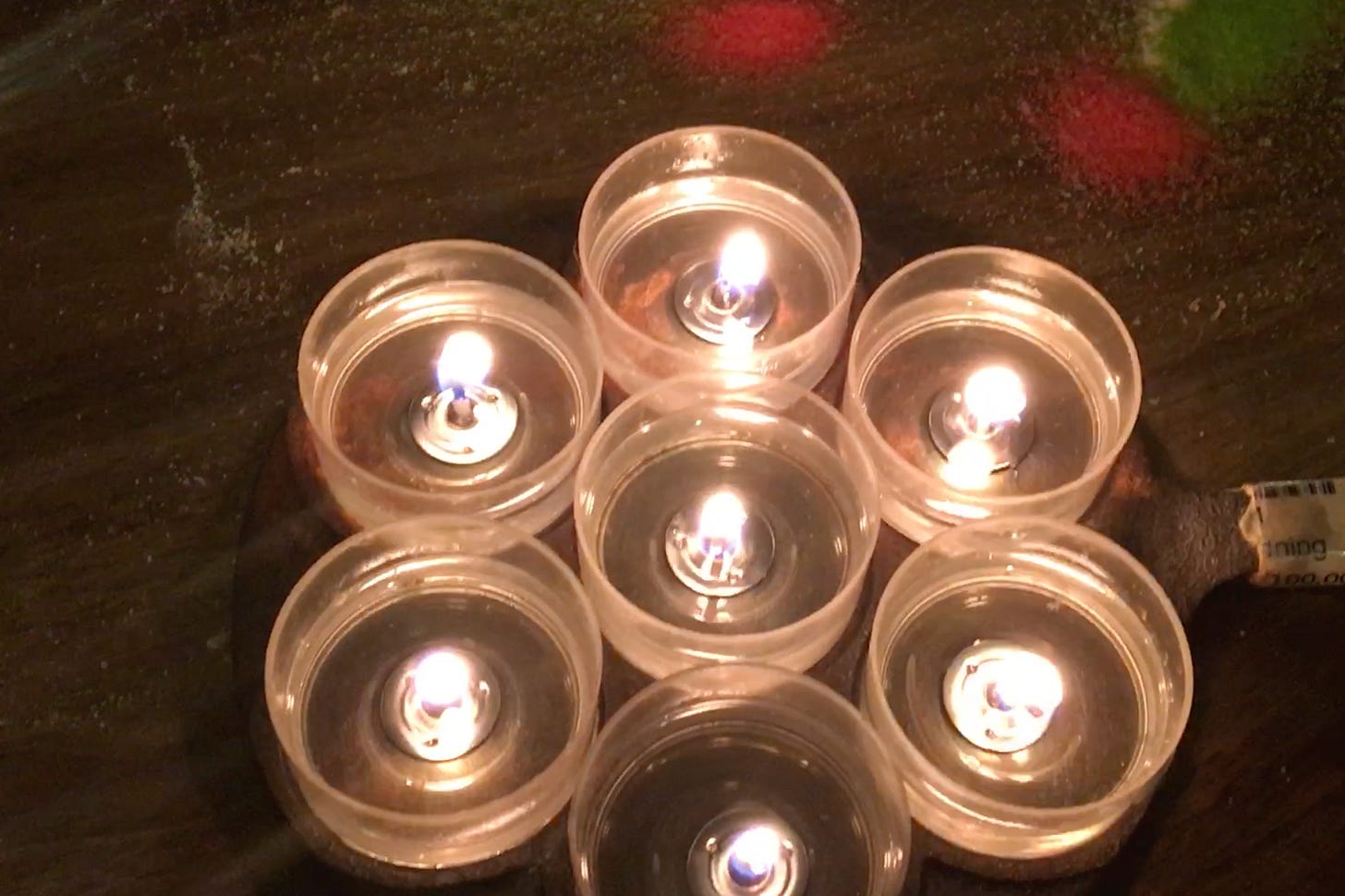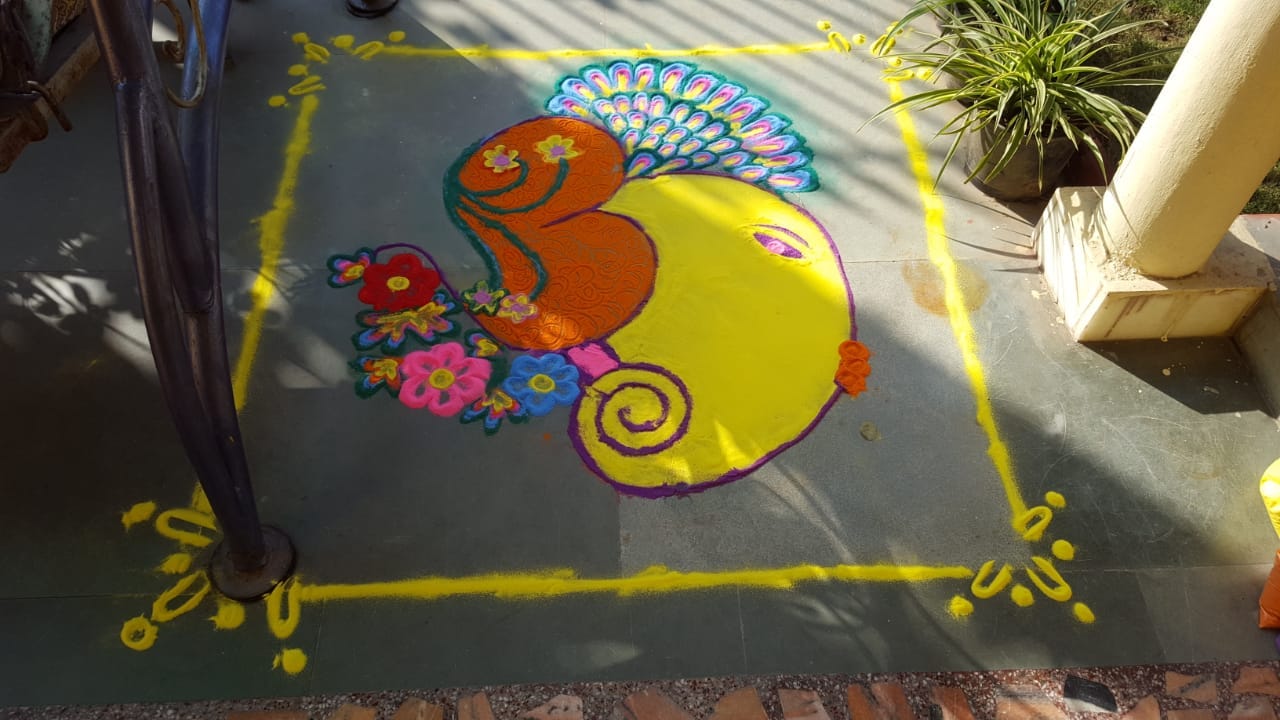Om asto ma sad gamaya,
Tamso ma joytirgamaya,
Mrityorma amritam gamaya (Rig Veda).
O God! Lead us from untruth to truth.
From darkness of ignorance to the light of knowledge
and from the cycle of birth and death to immortality.
The Rig Veda, one of the oldest texts known
This above shloka1 was printed on the notebooks we bought for school. It was also recited in school during the morning prayer. Asking the Gods, the divine to illuminate our minds. To take us towards the truth. Lead us to immortality.
Immortality not of the flesh, but in the context of knowledge.
For they say, ‘The truth shall set you free.’ John 8:31-32, The Bible.
And that is why, ‘Let there be light!’ (Genesis)
The Light
Light has been honoured in every religion and civilisation. The concept of light is presented in different forms. It can come through prophets, messengers, or the divine herself taking a human form. The best form of light is the one that shines from within. When we become the sun. The source of light herself.
The prominent aim of religions is to bring us inwards to awaken the goodness in us. In Hinduism they go even further, and say, ‘to awaken the God within.’
Many of our rituals that we devote towards the Gods are also conducted towards people. For example, bowing, joining of hands and saying ‘Namah Asti’ (Namaste, I bow—to the divinity in you).
And conducting an ‘aarti.’ A ritual that removes obstacles and darkness. We do it for our Gods (for they take so much of our pains, we bow and ask them to share their burdens with us too) and we do it all those who visit us, on every birthday, wedding and anniversary. So the Gods and goodness are evoked at every step, in every form.
Deepawali
An important but not very well known aspect of Hinduism, is that there are hundreds of celebrations throughout the year. Not the just big ones that the world knows, such as Holi, the festival color, Deepawali, the festival of lights.
This November 12th is Deepwali, the festival of lights. In the recent years, it has even been celebrated in the White House. Presented as a festival where good wins over evil, Deepawali has myriad stories, myths and legends associated with it.
An article written for a class illustrates2 just how rich this festival is in stories. It is a culmination of several festivals that begin around August. If India is the land of festivals, Hinduism a faith of celebration3.
As I wrote in the article
Time comes to Hindus not as a series of bland unwritten days, but fully endowed with differentiating qualities and attributes. So there are days for fasting, and days for feasting, days for celebrations and days to commemorate those who have passed on, days to work and (believe it or not) days to abstain from work, if only for a few hours.
There are even days when no fire is lit in the kitchen, meaning the family eats the food cooked the night before. There are days recommended when one should invest in buying metal, especially precious metals like gold and silver. The festival called the wealthy thirteenth, which falls on November 10th this year, honors the Gods associated with prosperity. It is auspicious to buy metal on this day.
Dhanteras, meaning the ‘wealthy thirteenth’. Dedicated to the God of wealth Kubera and Goddess Lakshmi, this day is a reminder of how prosperity in our lives is associated less with material wealth and more with loving relationships. Women, in previous days hurried to the brass market to obey one of the injunctions of the day- purchase a new brass pot. Appropriate pots and pans are required for cooking and therefore associated with continuing the tradition of family dinners. Now-a-days since brass is not that prevalent, women prefer to buy steel or some electrical gadgets.
When I lived in Fiji, I noticed that keeping the tradition alive, even a century away from their homeland, Indo-Fijian stores announced special discounts for Dhanteras.
Is it superstition? Are these many millennia old festivals an old form of consumerism from ancient India? Not if you understand the concept of Panchanga, the Hindu calendar.
Panchanga, a lunar calendar, estimates dates and times by the phase of the moon. Of five limbs of time treated by panchanga two most important are the lunar day (tithi) and the solar day (varna). Like the solar calendar used in the west, Panchanga has twelve months. However, the length of a month in Panchanga is slightly shorter than that in its solar counterpart, because it follows the monthly cycle of the moon (28 days).
Therefore, every three years, there is an extra month added to the calendar. It affects only how and when the Hindu festivals are celebrated, so India’s interaction with the world continues without interruptoin.
Panchanga is filled with astrological charts, auspicious dates, instruction for religious performances, and other details of the month. Panchanga is often consulted when choosing the date for weddings and starting new ventures.
To Hindus, there is ‘truly a time for everything.’ There are auspicious days recommended for getting married, for any venture started during those days is supposed to be fruitful. Then there are days when weddings are stalled. For those days are not auspicious.
Having lived in many countries and cultures, I am now beginning to understand the depth of analysis that Hindus put in every aspect of life.
Once I asked a colleague from Canada, who was heavily into ‘Vedic Astrology’, ‘Why do you believe in this, er, pseudo science?’
‘We are all made of the same material that stars are made of. We are affected by the movement of planets. If there is a way, I can guide my life, even a bit by the help of these charts, I see no issue in it.’
He was not defending, arguing or confronting. He was simply stating something that we cannot deny.
Deepawali outside of India
It was my fortune to spend a few years in Fiji and enjoy its delightful Diwali. In an article I wrote for one of the Fiji magazines I explained how it felt like being a child again in India.
In Fiji, I felt the same excitement as I did in India. The entire country lit up like a young girl, frolicking and giggling. Friends visit each other. For at least a week it is a fashion party for women. They wear new clothes, and show off their jewellery. The following video from a Vlogger gives a glimpse, but only a glimpse. The grandeur of Diwali in Fiji is something else. You can feel the energy in the air.
Each Day Is Unique
Deepawali4, meaning a row of lights, among other things welcomes Lord Ram after he defeats demons. Since it falls on a new moon day, people light his path home. Goddess of fortune visits us at night, but she goes only to the clean houses. Therefore, our cleaning spree starts a month before Deepawali. Gorgeous floral detractions are made at the entrance and inside the house.
The following is the one my niece made, where she adorns Lord Ganesh with Peacock feathers. Traditionally, these floor decorations were made of flour and spices, so that they could be food for ants. A daily ritual that includes kindness towards ‘other beings’ is the core of Hinduism.
Welcome lamps are left outside the house and in every room. No one sleeps on Deepawali night, least of all new borns, for there is too much fun (and too many fire-crackers :).
Here is an ad that takes Goddess Lakshmi’s preference for cleanliness and turns it into a public campaign for cleanliness. The only spoken sentence in the ad is in Hindi. However, the story in the ad is easy to understand. The last sentence says, ‘We all want Goddess Lakshmi in our homes, but she prefers cleanliness. If you are littering, don’t be surprised if she leaves your home.’ Goddess Lakshmi is always dressed in red, the color of prosperity and life, wears gold and precious stones. She always holds, among other things, a pot of Gold, a symbol of auspiciousness and wealth. Notice the lotus in her hand, a reminder to stay beautiful and untouched by the grime of this world, like the flower that blooms in stagnant waters. It’s all about bringing good fortune into our lives.
And who doesn't want auspiciousness?
But the concept of each-day-unique is reflected in Hindus concept of time and understanding of when and how to perform various duties. Continuous planetary movements provide us with new opportunities. Staying focused on what we want to create, can put us in the right place at the right time. Hence the constant focus on ‘auspicious time’.
The morning is always auspicious. It is the time to thank the Divine. Each day is a unique opportunity to begin anew. Each day is new chance to be better.
Here is a clip from last year’s celebration.
This Deepawali, November 12th, I wish that you all are lead toward the light, by your inner light.
Shloka or śloka (Sanskrit: श्लोक śloka, from the root श्रु śru, lit. 'hear'[1][2] in a broader sense, according to Monier-Williams's dictionary, is "any verse or stanza; a proverb, saying";[3] but in particular it refers to the 32-syllable verse, derived from the Vedic anuṣṭubh metre, used in the Bhagavad Gita and many other works of classical Sanskrit literature.[4] Source Wikipedia
I edited these articles and published them first in magazines in Fiji. Then with a further edit, I added them in public forums. Much of these are accessed by school children writing essays for the festival.
https://www.boloji.com/articles/6706/the-festival-of-lights
Diwali is an anglicised short version. The actual word is ‘Deepawali’ meaning a row of Lights.



